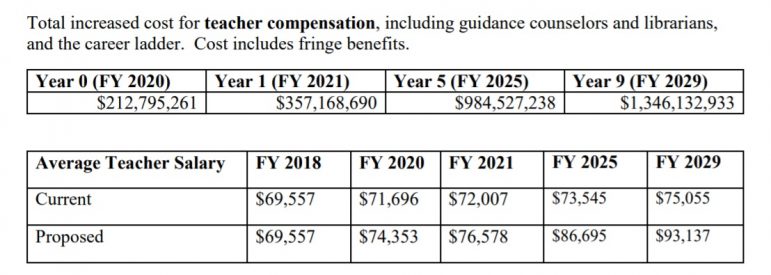By Len Lazarick
The Kirwan Commission on Innovation and Excellence in Education has begun hanging price tags on its recommendations for major education reform.
The commission chair, former University System Chancellor Brit Kirwan, has emphasized that the state would not just funnel more money into the status quo of Maryland public schools, but would require major changes in how education is delivered and teachers work to justify new spending phased in over 10 years.
Mandated school funding is already the second largest outlay in the state budget.
One of the commission’s major findings is that teachers are paid 25% less than comparable professionals with comparable education and responsibilities, one of the causes for a shortage of qualified teachers and students training to be teachers.
10% pay hike
The commission will be proposing a major bump in teach pay, raising pay for all Maryland public school teachers by 10% between 2020 and 2022, with a minimum teacher salary of $60,000 phased-in by 2024.
The commission is also proposing a new career ladder for teachers and additional certifications for teachers under the National Board for Professional Teaching Standards. This will raise average teacher pay in Maryland from the current $69,557 to $93,137 by 2029. In the final year of phase-in, the additional state spending is $1.3 billion, according to preliminary costs estimates by the Department of Legislative Services.

Source: Department of Legislative Services
Accompanying these pay raises, the commission is also recommending a reduction in actual classroom teaching time from 80% of the current school day to 60%. This will give teachers more time “to tutor students who need intensive help and work together in teams to use data and observation to identify students who are falling behind and collaborate on getting them back on track, develop highly engaging and effective lesson plans, mentor new and struggling teachers and systematically improve the school’s instructional program using applied research.”
Based on the experience of high-performing schools around the world, the reduction of teaching time will be accompanied by an increase in class sizes justified by more effective curriculum.
“These reductions in instructional time will require an additional 14,685 teachers by 2029 to continue providing the same number of classes,” says the report. Price tag in final year 2029 is another $1.3 billion.
Staggering figures
Conscious that the numbers are staggering, at its Nov. 14 hearing Kirwan emphasized that these are only preliminary numbers.
“These numbers will not reflect any savings that will be made based on the savings of other work groups,” Kirwan said. “No one should leave this room writing or reporting these figures as being the number for any work group. It is a gross number. It has not been netted out.”
“It would be inaccurate to simply add together each element and characterize this as a total cost,” Kirwan went on. “Cost overlaps have not been fully adjusted. Cost savings have not been incorporated.
The commission has not yet tried to work out formulas for how the state and local governments will share in the new costs.
As the costs estimates are rolled out, commission members also noted that there may be additional costs for new buildings associated with increasing the number of teachers or class sizes.
Commission member Crag Rice, a member of the Montgomery County Council, also noted that if you raise the salaries for some, other employees of county government will want similar raises.
The commission will hold hearings on its proposals on Thursday, Nov. 29 for statewide organizations at 3 p.m. and for individuals at 5:30 p.m. Sign-up is required by noon on Thursday.




Recent Comments